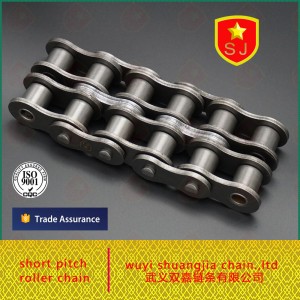Roller chains are widely used in various industries for power transmission purposes. They are known for their durability, high load capacity and efficient performance. However, understanding the working load of a roller chain is critical to ensuring its proper functioning and longevity. In this blog, we will delve into the concept of roller chain workloads and discuss their importance in industrial applications.
Understand the workload:
In simple terms, the working load of a roller chain is the maximum force or load that the chain can safely withstand during operation. This load is determined by factors such as chain size, material strength and its specific application. Manufacturers provide load capacity charts to help users choose the appropriate roller chain for their specific requirements.
Factors Affecting Workload:
1. Chain size: The size of the roller chain plays a vital role in determining its working load. Larger chains generally have a higher load capacity due to their stronger material and greater contact area with the sprockets. Therefore, the correct chain size must be selected based on the load requirements of the application to ensure optimum performance and prevent premature failure.
2. Material strength: Roller chains are made of different materials according to the needs of the application, such as carbon steel, stainless steel, or even nickel-plated steel. The strength of the material directly affects the carrying capacity of the chain. It is critical to select a roller chain with the proper material strength to withstand the expected loads and environmental conditions.
3. Lubrication and maintenance: Proper lubrication plays an important role in reducing friction and wear and enhancing the bearing capacity of roller chains. Regular maintenance, including cleaning and lubricating your chain, will not only increase its workload, but will also extend its life.
Understanding the importance of workloads:
1. Safety: Knowing the working load of a roller chain ensures that it is not subjected to excessive external forces that may cause failure or accidents. Overloading a chain can cause irreversible damage, resulting in costly repairs, production downtime and potential safety hazards. Knowing the workload enables users to select the correct chain for their specific application, ensuring a safer working environment.
2. Efficiency: Using a roller chain with the proper working load helps to maintain the optimum efficiency of the power transmission system. An overloaded chain can cause increased friction, heat and reduce overall system performance. By understanding the workload, users can select the appropriate chain that can handle the load demands efficiently, resulting in smooth and reliable operation.
3. Cost savings: Choosing a roller chain with the correct working load can prevent premature wear and failure, thereby reducing unscheduled maintenance costs. Investing upfront in the right roller chain can save money in the long run by avoiding frequent replacements and production interruptions.
Understanding the operating load of a roller chain is critical to selecting the correct chain size, material strength and lubrication requirements. By considering these factors, industry can ensure the safe and efficient operation of transmission systems while minimizing costs associated with maintenance and downtime. Therefore, manufacturers, maintainers and end users must understand the workload of roller chains in order to make informed decisions when selecting and using these important components.
Post time: Aug-08-2023

